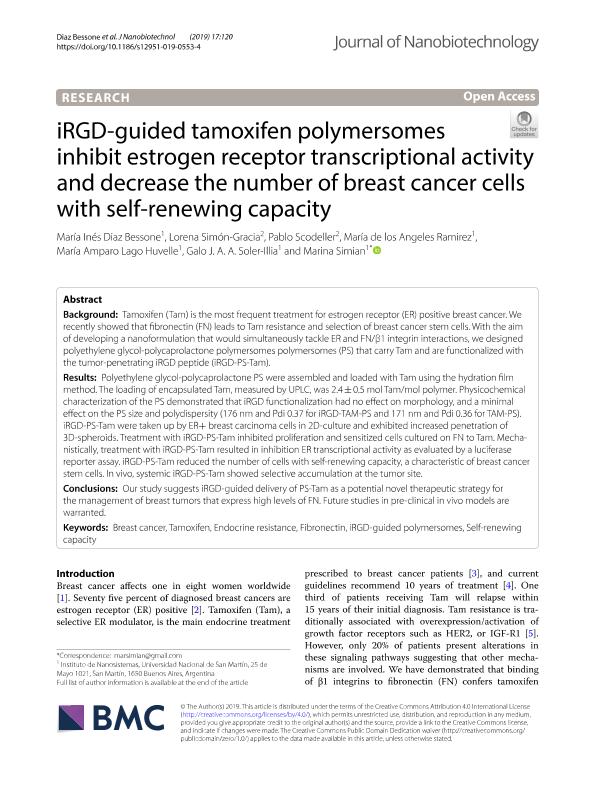Mostrar el registro sencillo del ítem
dc.contributor.author
Díaz Bessone, María Inés

dc.contributor.author
Simón Gracia, Lorena

dc.contributor.author
Scodeller, Pablo
dc.contributor.author
Ramirez, Maria de Los Angeles

dc.contributor.author
Lago Huvelle, María Amparo

dc.contributor.author
Soler Illia, Galo Juan de Avila Arturo

dc.contributor.author
Simian, Marina

dc.date.available
2022-10-26T17:26:29Z
dc.date.issued
2019-11
dc.identifier.citation
Díaz Bessone, María Inés; Simón Gracia, Lorena; Scodeller, Pablo; Ramirez, Maria de Los Angeles; Lago Huvelle, María Amparo; et al.; IRGD-guided tamoxifen polymersomes inhibit estrogen receptor transcriptional activity and decrease the number of breast cancer cells with self-renewing capacity; BioMed Central; Journal of Nanobiotechnology; 17; 1; 11-2019; 1-14
dc.identifier.issn
1477-3155
dc.identifier.uri
http://hdl.handle.net/11336/175014
dc.description.abstract
Background: Tamoxifen (Tam) is the most frequent treatment for estrogen receptor (ER) positive breast cancer. We recently showed that fibronectin (FN) leads to Tam resistance and selection of breast cancer stem cells. With the aim of developing a nanoformulation that would simultaneously tackle ER and FN/β1 integrin interactions, we designed polyethylene glycol-polycaprolactone polymersomes polymersomes (PS) that carry Tam and are functionalized with the tumor-penetrating iRGD peptide (iRGD-PS-Tam). Results: Polyethylene glycol-polycaprolactone PS were assembled and loaded with Tam using the hydration film method. The loading of encapsulated Tam, measured by UPLC, was 2.4 ± 0.5 mol Tam/mol polymer. Physicochemical characterization of the PS demonstrated that iRGD functionalization had no effect on morphology, and a minimal effect on the PS size and polydispersity (176 nm and Pdi 0.37 for iRGD-TAM-PS and 171 nm and Pdi 0.36 for TAM-PS). iRGD-PS-Tam were taken up by ER+ breast carcinoma cells in 2D-culture and exhibited increased penetration of 3D-spheroids. Treatment with iRGD-PS-Tam inhibited proliferation and sensitized cells cultured on FN to Tam. Mechanistically, treatment with iRGD-PS-Tam resulted in inhibition ER transcriptional activity as evaluated by a luciferase reporter assay. iRGD-PS-Tam reduced the number of cells with self-renewing capacity, a characteristic of breast cancer stem cells. In vivo, systemic iRGD-PS-Tam showed selective accumulation at the tumor site. Conclusions: Our study suggests iRGD-guided delivery of PS-Tam as a potential novel therapeutic strategy for the management of breast tumors that express high levels of FN. Future studies in pre-clinical in vivo models are warranted.
dc.format
application/pdf
dc.language.iso
eng
dc.publisher
BioMed Central

dc.rights
info:eu-repo/semantics/openAccess
dc.rights.uri
https://creativecommons.org/licenses/by/2.5/ar/
dc.subject
BREAST CANCER
dc.subject
ENDOCRINE RESISTANCE
dc.subject
FIBRONECTIN
dc.subject
IRGD-GUIDED POLYMERSOMES
dc.subject
SELF-RENEWING CAPACITY
dc.subject
TAMOXIFEN
dc.subject.classification
Bioquímica y Biología Molecular

dc.subject.classification
Ciencias Biológicas

dc.subject.classification
CIENCIAS NATURALES Y EXACTAS

dc.title
IRGD-guided tamoxifen polymersomes inhibit estrogen receptor transcriptional activity and decrease the number of breast cancer cells with self-renewing capacity
dc.type
info:eu-repo/semantics/article
dc.type
info:ar-repo/semantics/artículo
dc.type
info:eu-repo/semantics/publishedVersion
dc.date.updated
2022-10-26T10:45:06Z
dc.journal.volume
17
dc.journal.number
1
dc.journal.pagination
1-14
dc.journal.pais
Reino Unido

dc.description.fil
Fil: Díaz Bessone, María Inés. Universidad Nacional de San Martin. Instituto de Nanosistemas; Argentina. Consejo Nacional de Investigaciones Científicas y Técnicas; Argentina
dc.description.fil
Fil: Simón Gracia, Lorena. University of Tartu; Estonia
dc.description.fil
Fil: Scodeller, Pablo. University of Tartu; Estonia
dc.description.fil
Fil: Ramirez, Maria de Los Angeles. Consejo Nacional de Investigaciones Científicas y Técnicas; Argentina. Universidad Nacional de San Martin. Instituto de Nanosistemas; Argentina
dc.description.fil
Fil: Lago Huvelle, María Amparo. Consejo Nacional de Investigaciones Científicas y Técnicas; Argentina. Universidad Nacional de San Martin. Instituto de Nanosistemas; Argentina
dc.description.fil
Fil: Soler Illia, Galo Juan de Avila Arturo. Consejo Nacional de Investigaciones Científicas y Técnicas; Argentina. Universidad Nacional de San Martin. Instituto de Nanosistemas; Argentina
dc.description.fil
Fil: Simian, Marina. Universidad Nacional de San Martin. Instituto de Nanosistemas; Argentina. Consejo Nacional de Investigaciones Científicas y Técnicas; Argentina
dc.journal.title
Journal of Nanobiotechnology
dc.relation.alternativeid
info:eu-repo/semantics/altIdentifier/url/https://jnanobiotechnology.biomedcentral.com/articles/10.1186/s12951-019-0553-4
dc.relation.alternativeid
info:eu-repo/semantics/altIdentifier/doi/http://dx.doi.org/10.1186/s12951-019-0553-4
Archivos asociados
